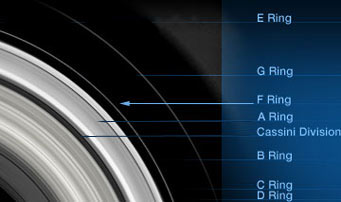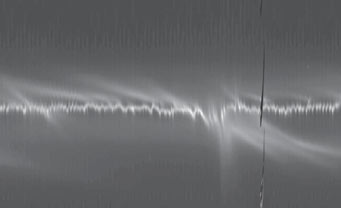Big space objects aren't the only ones who throw their weight around. At least that's what scientists are finding in Saturn's outer rings, where new observations from NASA's Cassini spacecraft pin responsibility for twists in the planet's F ring on tiny moons. The results appear in the June 5th Nature.

Diagram of Saturn's rings. Saturn lies just below the lower left corner.
NASA / JPL
"Saturn's F ring is perhaps the most unusual and dynamic ring in the solar system," says Carl Murray, the team's leader and a professor at Queen Mary, University of London, in a press release. "It has multiple structures with features changing on a variety of timescales from hours to years." The rope-like F ring is the third outermost of Saturn's rings and lies roughly 87,000 miles (140,000 km) from the planet's center.
The team found two different types of features: "jets" and "fans." The jets are extensions of ring material either toward or away from the planet that look like smears through a straight chalk line. They likely arise from collisions between material in the ring's central concentration and surrounding satellites. Fans, on the other hand, are a series of furrows that converge in the ring that scientists believe result from the gravitational effects of embedded satellites.
Numerical simulations for two features indicate diameters of 9 and 44 miles (14 to 70 km) for the guilty satellites, although multiple smaller satellites may offer a better solution for producing fans than one moon the size of Rhode Island. Other fans also suggest smaller culprits. Two objects seen by Cassini, called S/2004 S 6 and F07090QB, fit the team's data.

F ring mosaic showing the straight "outside" (pointing away from Saturn) and "inside" (pointing toward Saturn) jets found with Cassini. The image's lower edge faces Saturn.
C. Murray et al. / Nature
Earlier studies determined that the moon Prometheus plays a prominent role as well. Murray's team believes that Prometheus, which orbits just inside the F ring, directly clears channels in the ring and also off-balances embedded objects that then gravitationally affect the surrounding material.
The scientists think that the processes responsible for the jets and fans parallel how planets coalesce by accreting material from a dust plane. They hope to use the F ring observations to better understand planet formation.
 0
0
Comments
You must be logged in to post a comment.